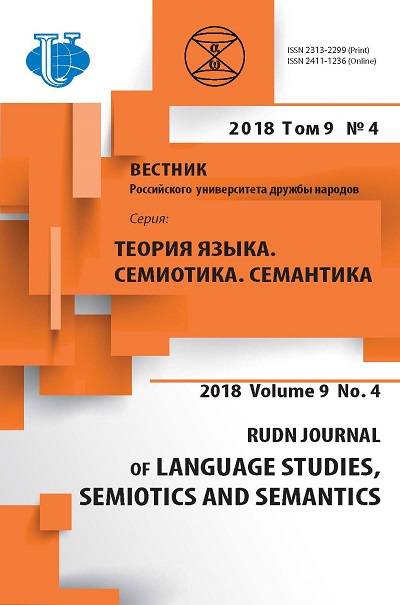SYNTACTIC STYLISTIC TRADITIONS AND INNOVATIONS OF THE EPOCH OF POETIC-PROSAIC INSEPARABILITY (on the material of english belles-lettres of XIV-XV centuries)
- Authors: Vyshenskaya Y.P1
-
Affiliations:
- Herzen State Pedagogical University
- Issue: Vol 9, No 4 (2018)
- Pages: 812-830
- Section: LANGUAGE HISTORY
- URL: https://journals.rudn.ru/semiotics-semantics/article/view/20140
- DOI: https://doi.org/10.22363/2313-2299-2018-9-4-812-830
Cite item
Full Text
Abstract
The article concerns the matter of English prose belles-lettres style the XIV-XV century known as an epoch of poetic-prosaic balance. The process of the artistic style generating is studied on the basis of the exemplary corpus fixed in the textual material of literary works belonging to the genre of the medieval romances as the earliest representative of a new literary genre. When considered fragmentary as one of basic parameters of verbal medieval art is taken into account. That means a complex approach in the sphere of study of the medieval textual documents. The style phenomenon is researched within the scope of a universal socio-cultural context as a part of thе “international Gothic” dominating during the period under study. Style generating processes in English literature marked by its national properties are analysed as part of the universal process of the European literary process. Comparative analysis of works of verbal as well as of non-verbal art of the period of stylistic borrowing from one art sphere to another is considered as based on the dominating stylistic ideas and specific features of world-vision proper the transfer from Middle Ages to the Renaissance. Comparative method gives an opportunity to trace peculiarities of transforming poetic material form into prosaic one.
Keywords
About the authors
Yuliya P Vyshenskaya
Herzen State Pedagogical University
Author for correspondence.
Email: clemence_isaure@rambler.ru
Ph.D, Assosiate Professor of the Department of English Language and British Studies of Herzen State Pedagogical University; Scientific Interests: Historical Stylistics, History of Literature, History of Language, Literature studies, Stylistics, Text Linguistics
48, block 14, the Moika Embankment, St.-Petersburg, Russia, 191186References
- Zumthor, Р. (1978). Le Texte-Fragment In Langue Française. Grammaires du Texte Médiéval. Paris: Larousse, 40, pp.75—83.
- Hamilton, C. (2002). Conceptual integration in Christine de Pisan’s In City of Ladies. Cognitive Stylistics: Language and cognition in text. Amsterdam-Philadelphia: John Benjamins Publishing Company, pp. 1—23.
- Baugh, A. (1967). Literary History of England. NY & London: Appleton-Century — Crofts, Inc.
- Devyataykina, N.I. (2002). The origin of the Book Humanistic Cult in Petrarca’s Epoch. In The Book Within thе Scope of the Renaissance Culture. Мoscw: Nauka Publ., pp. 24—34. (In Russ.).
- Poirion, D. (1981). Le Miroir Magique In Le Cœur d’Amour Epris. Paris: Filippe Lebaud Editeur.
- Ovsyaniko-Кulikovsky, D.N. (1917). Prose and Poetry Theory. Petrograd. (In Russ.).
- Romanova, V.L. (1975). The Manuscript Book and Gothic Writing in France (с. XIII—XIV). On the materials of manuscript books of National State Library. Мoscow: Nauka publ. (In Russ.).
- Sukhachyov, N.L. (1978). The History Perspective in Indo-European Science. SPb: The Centre of St.-Petersburg Oriental Studies. (In Russ.).
- Аkvinskij, Fоmа (2002). Works. Мoscow: Еditorial URSS. (In Russ.).
- Starodubova, V.V. (1994). French Art In Renaisssance Art in Netherlands, France and England. Мoscow: Iskusstvo. pp. 127—144. (In Russ.).
- Dobiash-Rozhdestvenskaya, О.А. (1987). History of writing in the Middle Ages. Мoscow: Knigа. (In Russ.).
- Аlexeev, М.P. (1984). Literature of Medieval England and Scotland. Мoscow: Vysshaja shkola. (In Russ.).
- Ahern, J. (2005). Dionco’s repertory: Performance and writing in Boccaccio’s “Decameron”. In Performing Medieval Narrative. N-Y: Boydell & Brewer Ltd. рр. 41—61.
- Gordon, J.A. (1966). The Movement of the English Prose. London: Longmans.
- Nenarokova, М.R. (2012). Carolingian Eclogue: Text and Genre History. М.: IMLI RАN. (In Russ.).
- Kazumi, M. (1979). Syntax and Style in Early English. Finite and Non-Finite Clauses c. 900— 1600. Tokyo: Kaibunsha Ltd.
- Blake, N.F. (1977). The English language in medieval literature. London, Melbourne and Toronto: J.M. Dent & Sons Ltd; Rowman and Littlefield, Totowa, N-Y.
- Yevdokimova, L.V. (1999). At the Beginnings of the French Prose. Prose and Verse Form in French Literature: [abstract of dissertation]. Мoscow. (In Russ.).
- Yevdokimova, L.V. (2016). Style and Style System in Medieval European Literatures. In Styles in Medieval European Literatures. Мoscow: Nauka publ. pp. 4—29. (In Russ.).
- Berkov, V.P. (2011). Some ideas of the Language Norm In Works in General Linguistics. SPb.: S-Petersburg State University. Faculty of Philology. pp. 41—50. (In Russ.).
- Lobachyov, B.Z. (1982). Style Notion in French and Russian Languages In Syntax and Stylistics. Мoscow: Peoples’ Friendship University of Russia publ. pp. 83—107. (In Russ.).
- Yegorova, Т.P. (1985). About Old German Personal Proper names Poetics In Poetical Text Structure and Functioning. Мoscow: Nauka publ. pp. 107—115. (In Russ.)
- Le Morthe d’Arthur. URL: https://archive.org/details/lemortarhuror00malouft. (accessed: 10.07.2018).
- Le Morthe d’Arthur. URL: http.//www.d.lib.rochester.edu/teams/text/benson-and-foster-kingarthurs-death-alliterative-morte-arthur-part-ii. (accessed: 10.07. 2018).
- Parуs and Vienne. URL: https://archive.org/details/parisandviennenet00hazlgoog. (accessed: 14.07.2018).
- The Lyf of the noble and Crysten Prince, Charles the Grete. URL: https://archive.org/details/ stream/lyfofnoblecryste00caxtoft#page/200. (accessed: 17.07. 2018).
- William of Palerne. URL: https://archive.org/details/romanceofwilliam00guilouft. (accessed: 1.07. 2018).













